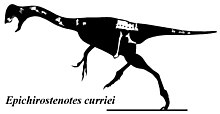Epichirostenotes
Appearance
| Epichirostenotes Temporal range: Late Cretaceous,
| |
|---|---|

| |
| Skeletal restoration | |
| Scientific classification | |
| Domain: | Eukaryota |
| Kingdom: | Animalia |
| Phylum: | Chordata |
| Clade: | Dinosauria |
| Clade: | Saurischia |
| Clade: | Theropoda |
| Family: | †Caenagnathidae |
| Subfamily: | †Caenagnathinae |
| Genus: | †Epichirostenotes Sullivan, Jasinski & Van Tomme, 2011 |
| Species: | †E. curriei
|
| Binomial name | |
| †Epichirostenotes curriei Sullivan, Jasinski & Van Tomme, 2011
| |
Epichirostenotes (meaning "above Chirostenotes", because it lived after the latter genus) is a genus of oviraptorosaurian dinosaur from the late Cretaceous. Epichirostenotes is known from an incomplete skeleton found in 1923 at the Horseshoe Canyon Formation, in strata dated to about 72 million years ago.[1] It was first named by Robert M. Sullivan, Steven E. Jasinski and Mark P.A. van Tomme in 2011 and the type species is Epichirostenotes curriei. Its holotype, ROM 43250, had been assigned to Chirostenotes pergracilis by Hans-Dieter Sues in 1997.[1]
See also
References
- ^ a b Robert M. Sullivan, Steven E. Jasinski and Mark P.A. Van Tomme (2011). "A new caenagnathid Ojoraptorsaurus boerei, n. gen., n. sp. (Dinosauria, Oviraptorosauria), from the Upper Ojo Alamo Formation (Naashoibito Member), San Juan Basin, New Mexico" (PDF). Fossil Record 3. New Mexico Museum of Natural History and Science Bulletin. 53: 418–428. Archived from the original (PDF) on 2018-10-04. Retrieved 2011-08-10.










